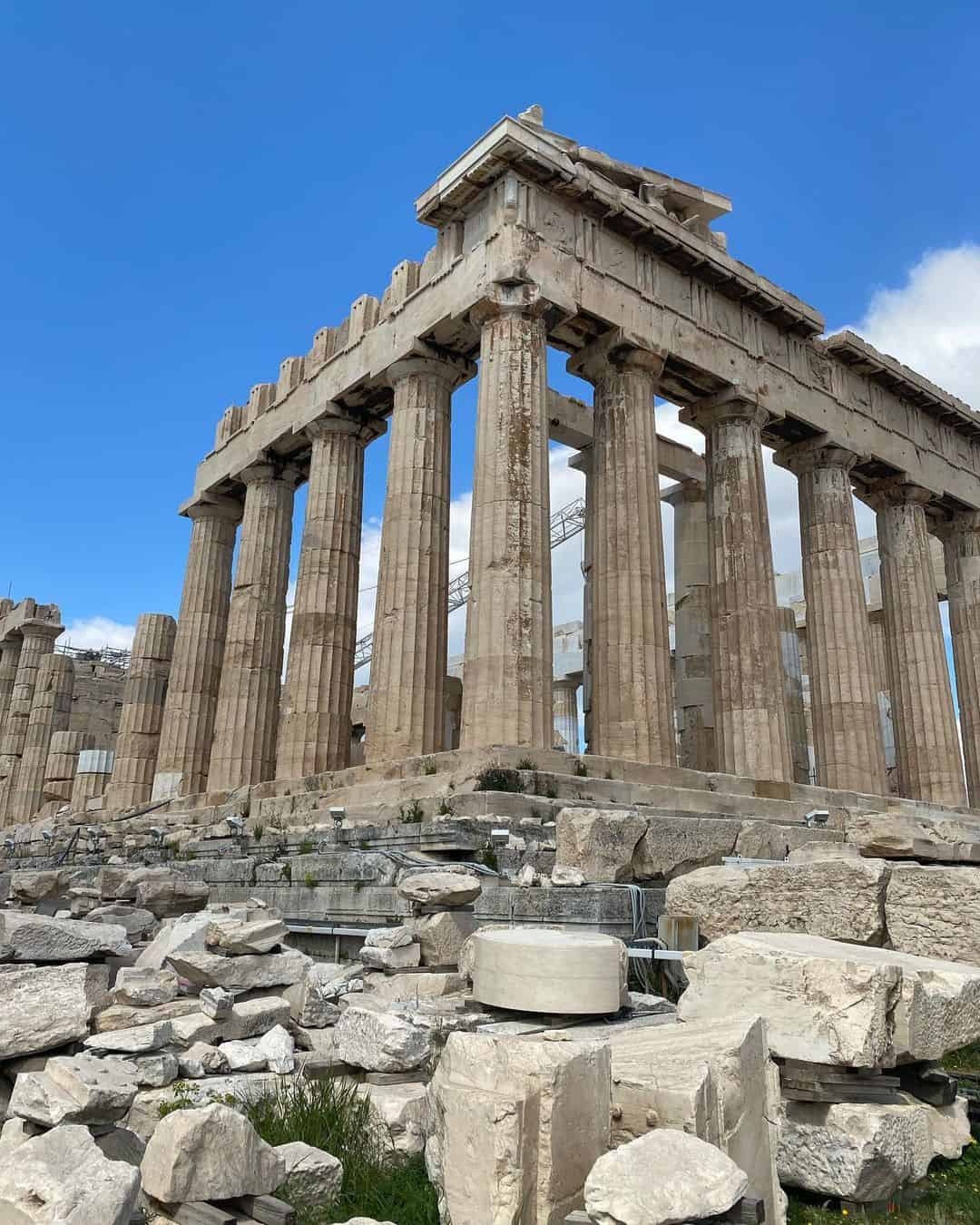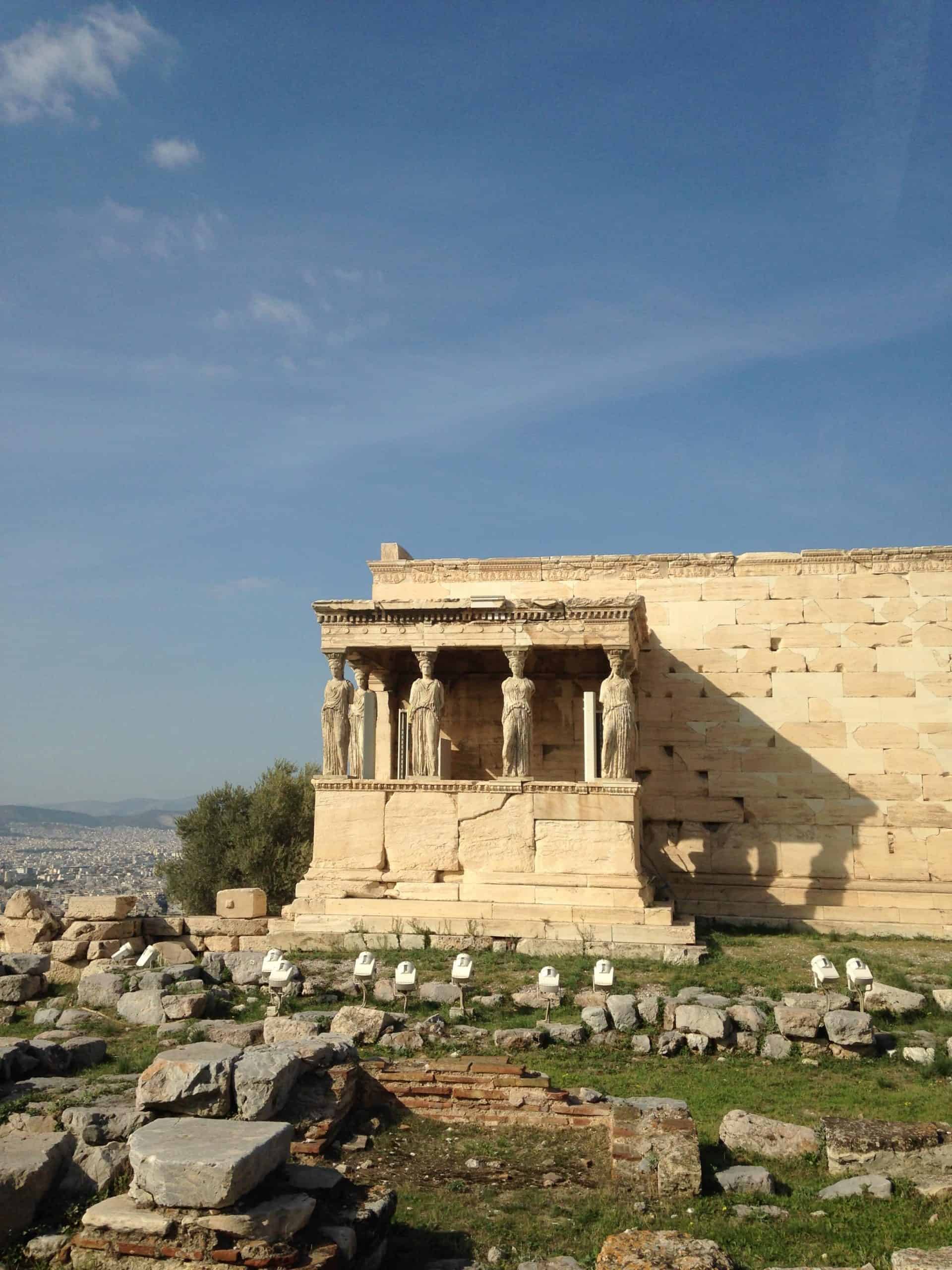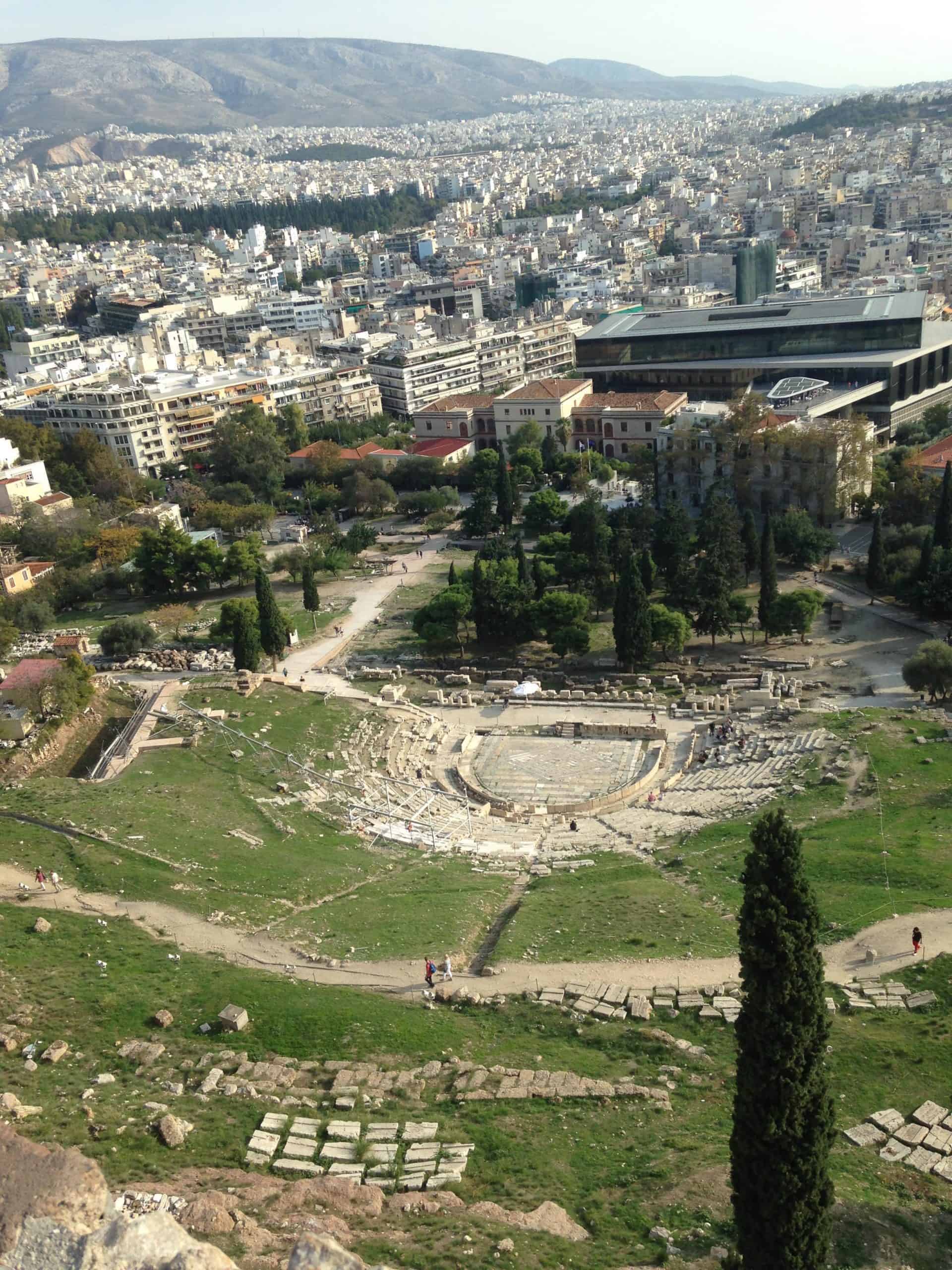Visiting the Acropolis is likely to be high on your list of things to do when visiting Athens for the first time. As a matter of fact, for a lot of people, the Acropolis hill and its magnificent Parthenon are the entire reason that they decide to visit the Greek capital in the first place!
The Acropolis is one of the city’s most famous landmarks. And no matter how much you have seen it photographed in travel literature or social media, nothing compares to seeing it up close and personal for yourself.
This guide to visiting the Acropolis has been written by someone who has lived in Athens for close to five years (me!) and who has visited the site numerous times. It outlines everything that you need to know before you go, a brief history of the various structures within the complex, and how you can secure the cheapest Acropolis entrance tickets.
The Acropolis of Athens

In ancient Greek, the word Acropolis meant ¨a fortified hill within a city¨. Thousands of years ago, virtually every Greek city boasted its own Acropolis, although time, destruction, and the elements have seen others around the country disappear.
Most Greek acropolises were built for defensive purposes whereas the Acropolis of Athens was built primarily for the worship of the Goddess Athena, the city’s patron saint. The Parthenon, built from Pentelic marble quarried from the flanks of Mt. Pentelikon, was largely built between 460-430BC when the city was ruled by Pericles.
It shares some design similarities with the nearby Temple of Hephaestus, in the heart of the Ancient Agora, as both were constructed around the same time. Sadly much of the original Acropolis building was destroyed by the Persians when they invaded in 480 BC.
The rocky bluff on which the Acropolis was built is said to have already been a place of spiritual importance for the locals. Legend had it that it radiated power and protection for Athenian residents.
So, it makes sense that this site would be chosen as a place to build an important temple for Goddess Athena.
The Acropolis site is actually more expansive than may initially meet the eye. There is more to see here than just the Parthenon.
Indeed, there are several different shrines, theatres, ceremonial arches, and grand colonnaded gateways within the Acropolis complex.
Visiting the Acropolis Athens 2024:
Tips and Advice

You should allow at least 2-3 hours for visiting the Acropolis Athens and its museum. Entrance to the Acropolis Museum is included in your Acropolis admission ticket.
The exhibitions here are well worth your time and allow you to gain additional context to the structures that you have seen on Acropolis hill. Some of the exhibits showcase artifacts that have been recovered from the region, whereas others are replicas. (Due to originals being held in the British Museum or the Vatican).
Consider purchasing an Athens combo ticket
You have a couple of options when it comes to purchasing your ticket(s) for visiting the Acropolis of Athens. You can opt to buy a ticket for the Acropolis only (which also includes the Acropolis museum) or you can buy an Athens combination ticket.
A standard Acropolis ticket costs €20 per person in the summer months (April 1 to October 31) and €10 per person in the winter months (November 1 to March 31). You can also consider purchasing an Athens combo ticket which includes admission to the Acropolis and 6 other major historical sites.
This also includes admission to the nearby Temple of Olympian Zeus, the Roman Agora, the Ancient Agora, Kerameikos, Hadrian’s Library, and Aristotle’s Lyceum. A combination pass is €36 which is worthwhile if you plan on visiting 2 or more of the above sites during your Athens itinerary, and especially if you are visiting in the summer.
(The Acropolis costs €20 to enter in the summer and the Ancient Agora costs €10. So you only have to visit one more site to make the combo ticket worthwhile).
You can find more information on the combo pass here.
Consider taking an Acropolis tour
An Acropolis tour is not necessary for visiting Acropolis Hill. Information plaques are scattered around the site and they help to provide a context of what you are looking at.
It is also possible to request an audio tour at the door. However, a guided Acropolis tour can help you gain more in-depth knowledge of one of the sites.
Better still? Exploring the Acropolis with an Athenian means that you have an Athens expert on hand to ask for recommendations on the best restaurants in the city, where to go for drinks, etc.
Best Acropolis Athens tours
A handful of the most reputable Acropolis tours are detailed below for your consideration. It is advisable to book online in advance to secure a place.
- Acropolis entrance ticket and guided walking tour
- Private tour of the Acropolis and its museum
- Early morning Acropolis and Plaka guided walking tour
- Acropolis and museum entrance tickets with an audio guide
- Skip-the-line Acropolis entrance ticket with an audio tour
Purchase your tickets online in advance to save time queuing
Whether you decide to purchase an Athens combination ticket, an Acropolis-only ticket, or participate in a tour, one thing that you should certainly do is make sure you purchase your tickets online in advance. That way, you avoid waiting in line when you arrive.
Your ticket will be sent to your email address. You can show the QR code on your phone (or print it, if you prefer) at the entrance when you arrive.
Notable Sights at the Acropolis

Did you know that the Athens Acropolis was almost one of the seven ¨new¨ wonders of the world? It became a finalist, but sadly just missed out on world wonder status.
The site has had UNESCO-protected status since 1987. You should read a little background history before visiting the Acropolis.
If you know why the various buildings were built and what they were used for, it helps you to appreciate this magnificent UNESCO-protected site even more!
The Propylaea
The Propylaea is the main entrance to the Acropolis. There are several routes that lead you to the site. However, it is worth entering via the Propylaea.
This way you can experience all of the grandeur that visitors to the Parthenon would have felt centuries ago. As you walk along the cobbled entryway of the Propylaea, you find yourself surrounded by imposing regal columnated walkways, and elegant marble buildings that have withstood the test of time.
The Temple of Athena Nike
After you enter the site via the Propylaea, you are met with another grand site: The Temple of Athena Nike. The temple dates back to 420BC, making it the very first temple constructed on Acropolis Hill.
In Ancient Greek, Nike means “victory”. It is believed that the Ancient Greeks would come and pray at this temple to wish for victories in battles.
The site has been repaired and reconstructed several times. But that does not detract from its charm.
The Pandroseion
The Pandroseion, the Erechtheion, and the Temple of Athena are three individual sanctuaries that are joined together. They almost look as though they are all the same building. However, each sanctuary served a very different purpose.
The Pandroseion was built in dedication to Pandrosus, daughter of Cecrops. Cecrops was the first King of Athens. He was believed to be half-man, half-snake
The Erechtheion
The Erechtheion is a building whose history is steeped in Greek mythology and magic. It is said that it was here where the Greek Gods Poseidon and Athena had the battle to decide who would become the God of Athens.
The two Gods would give gifts to the people so that they could decide who they preferred to worship. Poseidon struck a rock with his trident and from it spouted salt water, representing the sea.
Athena gave the Ancient Greeks the gift of an olive tree, representing prosperity. There is a damaged section of stone outside the Erechtheion which is said to be where Poseidon struck his trident.
The olive tree on the Western edge (since replanted) is said to be where Athena gave her gift. The structure of the Erechtheion in itself once housed a wooden statue of the Goddess Athena.
Look out for the Caryatids. These are six intricately carved female figures that support the roof of the building.
The Old Temple of Athena
In Greek mythology, Athena was one of the most important Goddesses. She was the daughter of Zeus.
Athena was known as the Goddess of courage, wisdom, inspiration, law, justice, strategic warfare, and mathematics. She was also the Protector of the city of Athens, and the reason that the Greek capital is named as such. (Athena is the Greek word for Athens).
The Old Temple of Athena stands on the right-hand side of the adjoined structures of the Pandroseion, the Erechtheion, and the Old Temple of Athena.
The Parthenon
The sun-bleached ruins of the Parthenon are the piece de resistance of the Acropolis Hill. No doubt they are the main reason that most people are interested in visiting the Acropolis.
This grand marble temple was built in dedication to the Goddess Athena. It sits perched atop a craggy outcrop that is visible from all corners of the city.
The building is pretty much constantly surrounded by scaffolding. Construction work has been going on here for years!
It is likely that this will remain here for a while to come, but the Parthenon is still very impressive. There are several theories regarding the specific use of the Parthenon.
Many believe that the building was used as a treasury. A concrete path was built around the site in 2021 to make it more wheelchair-friendly. However, this has caused some controversy in Greece as it certainly affects the historic integrity of the site.
The Theatre of Dionysus
The Theatre of Dionysus is an ancient theatre that was constructed on the southern slopes of the Acropolis hill in the 4th century. It is named after Dionysus, the God of Drama, and had the capacity to hold 17,000 spectators. Greek tragedies of Sophocles and Euripides took place here.
Viewpoints across Athens

As you explore Acropolis Hill, be sure to take the time to appreciate the views of the city all around you. You can enjoy especially nice panoramas from the highest points around the Parthenon and the Erechtheion.
From way up here, you have a magnificent view of the ramshackle streets of Athens beneath you. There will be two hilltops parallel to you on either side of the Acropolis. One is Mount Lycabettus, the other is Filopappou hill.
Look out for the ruins of the Ancient Agora, the Roman Agora, and the Panathenaic Stadium below. On a clear day, you can see all the way out to Piraeus port and the sea.
Odeon of Herodes Atticus
The Odeon of Herodes Atticus is one of the more “modern” buildings on Acropolis Hill. This grand theatre was constructed in 161AD during the Roman Era.
The Odeon was built by Herodes Atticus in dedication to his late wife. Today, the theatre still functions and often hosts theatrical performances and operas.
The “New” Acropolis Museum
Your ticket to the Acropolis site includes admission to the “New” Acropolis Museum. This is well worth a visit after meandering around the ancient ruins.
The museum is hailed as being one of the best museums in Athens. It provides a chronological history of the site and enables you to put the things that you have seen in more context.
The “New” Acropolis museum is housed inside a beautiful contemporary glass structure. It was designed by renowned Architects Bernard Tschumi and Michael Photiadis.
Sadly, it is only replicas of the Parthenon marbles that are stored here as the originals are in London. There is a wonderful coffee shop on the top floor of the museum. Order yourself a traditional Greek coffee and a hearty slab of spanakopita if you need to rest your legs between visiting historic sites.
The Forgotten Monument of Thrasyllus
The Forgotten Monument of Thrasyllus is not a site that you can visit. Unfortunately, the path to the monument is too damaged and inaccessible.
However, the monument is something that is worth looking out for as you glance up towards the Acropolis. As you walk along Dionysiou Areopagitou street, look up to the Acropolis.
You will see a mysterious little window in the southern wall with white columns. There is currently no way to reach this.
This is the Monument of Thrasyllus. It is believed that the monument was built in 320BC.
A religious shrine sits inside, with frescoes and monuments of the Virgin Mary. However, the Acropolis Guards stand watch to ensure that nobody tries to enter…
Visiting the Acropolis FAQs
Do you have any additional questions or concerns about visiting the Acropolis of Athens? Hopefully, you will find the answers you are searching for below.
Otherwise, feel free to reach out!
Admission Times
The Acropolis admission times vary from the summer to the winter seasons. The summer schedule runs from the 1st of April until the 31st of March each year. During this time, the Acropolis is open from 8 am until 8 pm.
The winter tourism season runs from November 1st to the 31st of March. In this period, the site is open from 8 am until 5 pm daily.
The Acropolis hill is closed on the below dates:
- January 1st
- March 25th
- May 1st
- Easter Sunday
- December 25
- December 26
Entrance to the Acropolis is Free on Certain Days
Various Athens attractions offer free admission on certain days of the year. This includes the Acropolis, and most archaeological sites and museums
Between the months of November and March, admission to most sites is free on the first Sunday of the month. You can also enjoy free admission on the following dates:
- 6th March
- 18th April
- 18th May
- The last weekend of September
- 28th October
How much time do you need to visit the Acropolis?
You should dedicate a minimum of 2-3 hours to visiting the Acropolis. That way, you can walk up to the Parthenon, sit and enjoy the panoramas over central Athens, snap some photos, wander around all the other structures at the site, and read their information plaques at a leisurely pace.
You could very easily spend an entire morning or afternoon here if you are very interested in history and choose to do an audio tour as you walk. Do also set aside 30-40 minutes to browse through the exhibits at the museum.
Is the Acropolis worth visiting?
The Acropolis is absolutely worth visiting, even if the entrance fee can feel quite pricey compared to other historical sites around the city. (Would you really want to go all the way to Greece and not see the Acropolis?)
Visiting the site and its museum helps you understand more about Ancient Greek history and culture. The Parthenon, the Theatre of Dionysus, and the Odeon of Herodes Atticus are every bit as spectacular as the guidebooks would have you believe, and when you visit, you will likely find yourself truly in awe at how intricate and well-preserved some of the structures you see here are.
Is there a dress code for the Acropolis?
There is no dress code for the Acropolis (or most places in Athens in general). Of course, you should have common decency when choosing your sightseeing wardrobe because the Acropolis is a family place. (e.g. no sheer/transparent dresses or explicit, vulgar slogans).
But you are free to wear dresses, shorts and t-shirts, and whatever you please. The Acropolis is not a religious site so you do not have to dress in a conservative manner as you would in say, a church or a monastery.
Is the walk to the Acropolis hard?
The pathways through the Acropolis complex take you on a steady incline up towards the Parthenon which watches over the city protectively from the top of the hill. The walk to the top is not especially steep.
It is very gradual and you don’t have to conquer lots of treacherous steps or anything like that.
Is there a toilet in the Acropolis?
There are two sets of toilets at the Acropolis site. One is near the main entrance, and another is at the top of the hill. You will also find vending machines and water fountains near the Propylea.
How do you skip lines at the Acropolis?
The best way to skip the lines at the Acropolis is to purchase a skip-the-line ticket or tour online in advance. Tickets purchased with a skip-the-line ticket service enable you to bypass any queues and walk right into the site.
Failing that, any Acropolis ticket bought online in advance is beneficial as it saves you from having to wait at any ticket kiosk/machine. Once you have purchased your ticket online, you will receive it as a QR code which you simply have to show at the entrance.
Who is eligible for free or discounted admission?
Certain groups of people are eligible for free or discounted admission to the Acropolis. This includes non-EU children under the age of 5, EU nationals under 25, students, people with disabilities, Greek unemployed citizens, and several others.
For the full list of who is eligible for discounted or free Acropolis admission, check the official site here. Keep in mind that you will be asked to show your ID to prove eligibility.
When is the best time to visit the Acropolis to avoid the crowds?
Athens is an excellent year-round travel destination. The Greek summer season that runs between June and September sees the Greek capital become virtually overrun with tourists.
The number of tourists in the city drops substantially after October and Winter in Athens can be very pleasant. Consider travelling out of season if you can. Greece sees mild temperatures all year round.
It is recommended to visit the Acropolis early in the morning when the site first opens (at around 8 am). Alternatively, stop by later in the evening before the sun starts to set.
What to wear and bring to visit the Acropolis
Wear comfortable shoes for visiting the Acropolis. The stones and pathways here are very uneven and sometimes slippery.
It should go without saying, but don’t wear high heels! There are even signs scattered around reminding you that high heels are prohibited.
Don’t forget to bring a hat, sunglasses, and sunscreen. It is not uncommon for summer temperatures in southern Greece to soar well above 40 degrees.
Take a bottle of water as there is nowhere to buy one once you are on the site. There are some vending machines right at the entrance, and plenty of excellent coffee shops and stores just outside the site in Makrygianni.
Handy apps and audio guides for visiting the Acropolis
You may wish to consider downloading an informative Acropolis App or an audio tour for your visit. Several audio tours are available online.
There are several useful apps available on the Google Play and Android App stores. This includes an Acropolis Interactive Educational 3D App and Acropolis Walking Tour apps.
The Rick Steves audio tour is a particularly good audio tour. It covers the Acropolis in addition to the nearby areas of Thissio, and Plaka.
Can I take my drone to the Acropolis?
It is illegal to use drones over archaeological sites in Greece. This includes the Acropolis. There is a €500 fine waiting for anyone that breaks this rule.
Is the Acropolis wheelchair accessible?
Officially yes, the Acropolis is wheelchair accessible. Disabled visitors and one escort are eligible for free admission to the site.
There is an elevator on-site that takes handicapped guests up to the Parthenon. Unfortunately in Greece, sometimes things are not always as they should be and there have been occasions when the elevator was not functional.
Contact +30 210 3214172 in advance of your trip, if travelling with a handicapped companion. This way you can check whether the elevator is currently functioning.
2021 saw a huge initiative to make the Acropolis more accessible for all. Flat, concrete paths were built throughout the complex, replacing the formerly uneven rocky paths, and making the site suitable for wheelchair users.
Where is the entrance to the Acropolis?
The main entrance to the Acropolis is the Propylaea. Follow the signs for the Acropolis from Acropoli metro station.
It will be very clear where the main entrance is. There is a small ticket office situated here.
The Propylaea entrance is usually the most crowded, as many tourists are not aware of a second side entrance that sits opposite the New Acropolis museum. If you have already purchased your tickets in advance or online, you may wish to enter through the side entrance so as to skip the crowds.
How to Get to the Acropolis
The Acropolis is very centrally located. It is just a short walk from Syntagma square, Monastiraki, and the quirky neighbourhood of Koukaki.
It is easy to get to the Acropolis from Athens airport or from the various neighborhoods in the city centre. Public transport in Greece is very good and it’s easy to get around.
The main metro station that services the site is the aptly named “Acropoli” station which sits on the red line of the Athens metro.
You can also take a metro to either Thissio or Monastiraki station and then walk from there. Download an offline Maps app such as Maps Me to help yourself navigate your way around the Greek capital.
What else to do near the Acropolis

The Acropolis is situated right in the heart of Athens city centre. This makes it a perfect jumping-off point for a wider exploration of ancient Athens. A few suggestions on how to continue your magical day in Athens are provided below.
Stroll along Dionysiou Areopagitou
Upon exiting back through the Propylaea and browsing the exhibits of the New Acropolis museum, wander down the pedestrianised boulevard of Dionysiou Areopagitou. Here, you will find dozens of pop-up stalls selling handicrafts and charming artisanal products that are oh-so quintessentially Greek.
This is a great place to pick up gifts and Greek souvenirs for your loved ones back home. Whatever day of the week you stop by, you will see street performers here performing everything from magic tricks to traditional bouzouki music.
Explore Thissio and Filopappou Hill
Dionysiou Areopagitou twists and turns through Thissio into areas of beautiful greenery that provide countless wonderful photo opportunities for taking pictures of the Acropolis. The hill that sits opposite the Acropolis is Filopappou Hill.
The shrine at the top of Filopappou offers alternative views over the Acropolis and the city of Athens. There are also several interesting sites that you can stop by on your ascent.
Don’t miss Socrates’ prison and the small, charming Athenian churches on the slopes of Filopappou. Similarly, nearby Pnyx hill is where the Athens democratic assembly would gather to discuss civil issues centuries ago.
Visit the secret village of Anafiotika Plaka
Anafiotika Plaka is a “secret” neighbourhood that escapes the eyes of most tourists. This neighbourhood has been decorated in Cycladic style and looks more reminiscent of a village from Santorini than a suburb of the chaotic Greek capital.
Anafiotika was constructed by Greeks that moved to the mainland from the island of Anafi. It is a must-see while in the capital city.
Spend your afternoon in Plaka
Plaka is Athens’ oldest neighbourhood. This area has a history that dates back more than 2,500 years.
Despite being one of the most touristic areas of Athens, there is something special and almost magical about Plaka. Some of the city’s most notable historical sites are here – including the Roman Agora and several ancient mosques.
If you start to feel hungry, there are several great Athens restaurants here that are beloved by locals. To Kafeneio (Epicharmou 1) is famous for its small meze plates and specialises in cuisine from Northern Greece.
Meanwhile, Scholarchio (Tripodon 14) is tucked away from view down a narrow alleyway. Locals come here for the specialty trout and flaming sausages.
Where to stay in Athens with an Acropolis view

There are several incredible rooftop bars in Athens that boast breathtaking Acropolis views. They are well worth adding to your radar if you plan on experiencing Athens by night.
You may also wish to stay at a hotel that offers views across to the Parthenon from your balcony. A few suggestions for hotels with Acropolis views are detailed below. You can also browse this detailed guide on where to stay in Athens.
AthensWas Hotel
Where: Dionysiou Areopagitou 5
AthensWas is a beautiful boutique hotel on Dionysiou Areopagitou. The rooms of this luxurious five-star property have been designed in a sleek, contemporary style.
From your private balcony, and from the hotel’s elegant rooftop Sense restaurant, you have magnificent views of the Acropolis. It is close that it feels as though you can reach out and touch it.
Rooms at AthensWas start from around €160 per night. Click here to browse the latest room rates and availability.
Acropolis View Hotel
Where: 10 Webster Street
Location location location. The Acropolis View Hotel offers a clean and charming stay in the heart of historic Athens.
From here, you are just a short walk away from Athens’ main attractions – including the Acropolis, Hadrian’s Arch, the Temple of Olympian Zeus, and Old Plaka. Breakfast on the scenic terrace offers you a chance to admire the Parthenon and the Acropolis as you sip your morning coffee.
Rooms at the Acropolis View Hotel start from €70 per night. Click here to browse the latest room rates and availability.
Final Thoughtson visiting the Acropolis Athens
Do you have any further questions about visiting the Acropolis of Athens, or planning a trip to Greece in general? I have been living in Athens for the past 4.5 years and have gotten to know the city pretty well during that time.
I have visited the Acropolis four times at this point, after being forced against my will (I jest) to play Tour Guide to visiting friends and family members.
Safe travels and enjoy Greece!
Geia sou!






1 Response
Hi Melissa,
Could you tell me what the story is with regards to Covid and the Acropolis?
Can you gain entry just with a negative test, or do you have to be fully vaccinated?
Thanks,
Ben